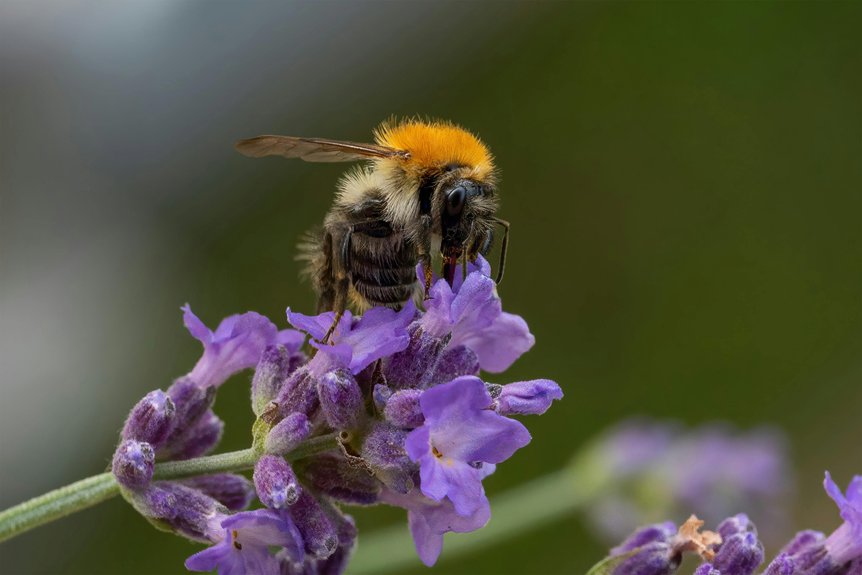You might think bees have just one pair of wings, but in fact, they possess two pairs: the larger forewings and the smaller hindwings. This unique wing structure is integral to their flight mechanics and plays an essential role in various aspects of their behavior. Understanding how these wings function not only reveals the complexity of bee anatomy but also highlights their importance in ecosystems. What happens when you consider their impact on pollination and environmental health?
Key Takeaways
- Bees have two pairs of wings: forewings and hindwings.
- Forewings are larger and primarily provide lift during flight.
- Hindwings are smaller and help with stability and maneuverability.
- The wings are essential for flight, pollination, and communication.
- Wing structure varies among species, affecting flight capabilities and ecological adaptations.
Understanding Bee Anatomy
Understanding the intricate anatomy of bees is essential for grasping their behavior and ecological role.
Bee anatomy comprises several specialized structures that facilitate survival and reproduction. Their exoskeleton, segmented body, and antennae play important roles in sensory perception and communication.
The two pairs of wings, critical for flight, are connected to the thorax, enabling agile maneuvers during foraging. Wing functions extend beyond locomotion; they assist in thermoregulation and signaling.
The forewings and hindwings interlock during flight, enhancing stability and efficiency. Recognizing these anatomical features allows you to appreciate how bees interact with their environment and contribute to ecosystems.
The Basics of Bee Wings
While you may often notice the graceful flight of bees, the structure and function of their wings are equally fascinating. Understanding these fundamentals can deepen your appreciation for these insects.
Here are key aspects of bee wings:
- Wing Types: Bees possess two pairs of wings—forewings and hindwings—allowing for agile maneuverability.
- Wing Colors: Typically translucent, bee wings exhibit colors ranging from light brown to darker shades, influenced by species.
- Wing Veins: Their intricate vein patterns provide structural support, essential for flight.
- Wing Movement: Bees can beat their wings rapidly, creating lift and enabling complex aerial movements.
Differences Among Bee Species
When you examine various bee species, you’ll notice distinct wing structure variations that influence their flight capabilities.
Some bees possess longer, more robust wings suited for sustained flight, while others have shorter, more agile wings optimized for quick maneuvers.
Additionally, each species showcases unique adaptations that reflect their ecological niches, underscoring the complexity of their evolutionary paths.
Wing Structure Variations
Bee species exhibit remarkable diversity in wing structure, which directly influences their flight capabilities, foraging strategies, and ecological roles.
You’ll find structural variations that include:
- Hymenopteran Wings: Most bees feature two pairs of wings, with forewings larger than hindwings.
- Wing Types: Some species possess specialized wings for specific environments, like short, broad wings for maneuverability in dense vegetation.
- Venation Patterns: Distinct wing venation influences aerodynamic efficiency.
- Wing Flexibility: Variations in wing stiffness can affect endurance and agility during flight.
Understanding these factors helps clarify how bees adapt and thrive in diverse ecosystems.
Flight Capabilities Comparison
Flight capabilities vary considerably among bee species, shaped by factors such as wing structure, body size, and ecological niche. Differences in aerodynamic efficiency and wingbeat frequency greatly influence their flight performance. For instance, larger bees tend to have lower wingbeat frequencies but can achieve greater flight endurance.
| Bee Species | Wingbeat Frequency (Hz) | Aerodynamic Efficiency |
|---|---|---|
| Honeybee | 230 | Moderate |
| Bumblebee | 150 | High |
| Carpenter Bee | 200 | Low |
Understanding these variations is vital for appreciating their ecological roles.
Species-Specific Adaptations
Numerous species of bees exhibit unique adaptations that enhance their survival and reproductive success in diverse environments.
These species adaptations showcase their evolutionary significance, allowing them to thrive in various ecological niches.
Consider these examples:
- Morphological Changes: Body size and shape vary, optimizing for specific floral types.
- Foraging Behavior: Some species specialize in collecting pollen from particular plants.
- Nesting Habits: Nest structures differ, providing protection and temperature regulation.
- Communication Methods: Unique dances or pheromones facilitate efficient information sharing.
These adaptations highlight the intricate relationship between bees and their ecosystems, underscoring the importance of conservation efforts.
The Function of Wings in Flight
Understanding the function of wings in flight requires you to examine their intricate structure and mechanics.
You’ll see how the coordination of wing movements enables bees to achieve remarkable agility and stability during flight.
Wing Structure Explained
The intricate structure of a bee’s wings plays an essential role in its ability to steer through the air with agility and precision.
Their design hinges on several key elements:
- Wing Muscle: Specialized muscles allow rapid wing beats, necessary for lift.
- Wing Flexibility: The wings can bend and twist, adapting to various flight conditions.
- Vein Structure: Rigid veins provide support while maintaining lightweight characteristics.
- Surface Texture: Tiny hairs on the wings enhance aerodynamics, optimizing airflow.
Together, these features enable bees to execute complex aerial maneuvers that are critical for foraging and steering their environment.
Flight Mechanics Overview
While you might think of a bee’s wings as merely tools for flight, their function extends far beyond simple propulsion.
These wings operate based on aerodynamic principles, generating lift through specific angles of attack and rapid flapping. When a bee beats its wings, air pressure differences create an upward force, allowing it to ascend and maneuver adeptly.
This lift generation is essential for foraging and navigation, enabling bees to exploit diverse environments.
Wing Coordination in Action
Bee flight isn’t just about generating lift; it heavily relies on the coordination of wing movements to achieve agility and stability in the air.
Through intricate wing synchronization, bees can execute complex flight patterns essential for foraging and navigation.
Key aspects include:
- Asynchronous Flapping: Each wing flaps independently to create turbulence.
- Angle of Attack Adjustments: Modifying wing angles enhances lift and maneuverability.
- Rapid Wingbeats: Increased frequency allows quick directional changes.
- Coordinated Recovery Strokes: Guarantees smooth shifts during hovering and acceleration.
Together, these elements enable bees to masterfully navigate their environment, showcasing their evolutionary adaptation.
Wing Structure and Adaptations
Understanding the intricate structure of wings reveals how bees have adapted to various environments and roles within their ecosystems. Their wings exhibit remarkable wing flexibility, allowing for agile maneuvers and efficient flight patterns. This flexibility is essential for traversing complex floral landscapes.
Additionally, wing coloration plays a significant role in thermoregulation and camouflage, helping bees blend into their surroundings or absorb heat. The combination of these structural features enhances their survival, enabling them to thrive in diverse habitats.
The Role of Wings in Pollination
Although often overlooked, the wings of bees play an essential role in the process of pollination. Their unique structure and movement facilitate efficient nectar collection and pollen transfer.
Here’s how wings contribute to this crucial function:
- Flight Stability: Wings enable agile maneuvers, allowing bees to navigate complex flower environments.
- Pollen Transport: As bees flap their wings, they create air currents that help dislodge pollen from their bodies.
- Foraging Efficiency: Rapid wingbeats allow bees to visit multiple flowers quickly, maximizing nectar collection.
- Communication: Wing vibrations signal other bees about fruitful foraging locations, enhancing the pollination process.
Fascinating Facts About Bee Wings
Wings aren’t just tools for flight; they showcase an impressive range of adaptations that enhance the survival and efficiency of bees.
You’ll find various bee wing types, including forewings and hindwings, each serving specific functions. This division allows for increased maneuverability and stability during flight.
The wing design evolution over millions of years reflects environmental adaptations, such as size variations that optimize energy use.
Additionally, the unique structure of bee wings aids in sound production and communication, essential for colony coordination.
Understanding these aspects reveals the intricate relationship between wing morphology and bee behavior in their ecosystems.
Conclusion
In summary, bees, with their two pairs of wings, exemplify nature’s engineering marvels. Think of them as miniature helicopters, expertly maneuvering through vibrant gardens and orchards. Their forewings provide the lift, while the hindwings guarantee stability, allowing them to perform intricate aerial dances among flowers. This unique wing structure not only enhances their flight but also boosts pollination efficiency, underscoring their essential role in our ecosystems. Without them, the colorful tapestry of our world would fade markedly.

